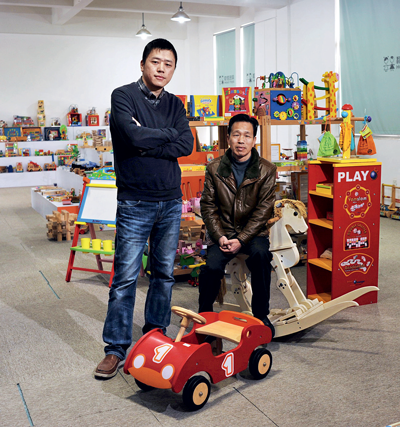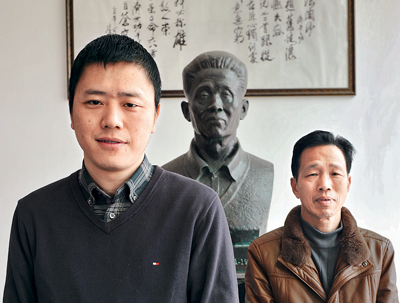My father shared many common characteristics of his generation in the 1970s—he cared about how to develop this factory and how to help the people survive and live decently. Last year (2011) some local businessmen and I donated our money to renovate a temple, where everyone could have a nice view of Yunhe County. I think it would be beneficial for us to unite together as one and think about the whole industrial picture.
—He Shangqing
Introduction
 Traditionally we think about the family business and its relationship to the family in terms of the family’s ownership of a single business. This frame of mind can oversimplify the way the family strategizes and thinks about their business or businesses.
Traditionally we think about the family business and its relationship to the family in terms of the family’s ownership of a single business. This frame of mind can oversimplify the way the family strategizes and thinks about their business or businesses.
There is oversimplification at two levels. First, the family might own, or family members might co-own, several businesses in different constellations. In the cases featured in this book, just one out of all the families, the Swedish family, owned only one company. Second, the family and its ownership might be a part of a wider social fabric of businesses that are within the same field, or providing related products, often known as a cluster region (or regional cluster) as proposed by Porter (1998). We will explore a best practice case that will illustrate how a founder business developed into a cluster of companies, owned by different family members. The development of these businesses was instrumental in, and happened concurrently with, the development of a cluster region for the production of a particular type of product.
Within the family business field the family and its engagement with the family business has often been explored through the three-circle model. This rests on the assumption of one family-one business. The original bivalent two-circle model well describes a family that owns a firm and three overlapping circles: (1) the family, (2) the business and (3) the ownership (Gersick, Davis, McCollom Hampton and Lansberg, 1997; Tagiuri and Davis, 1996). This model is also presented in Chapter 8. It focuses on the roles of owners, family members and employees and how they interact, and can be used to understand authority and the internal dynamic where there is one business and one family. However, only one family in our case material had a single company ownership structure and the three-circle model cannot capture the strategizing done with multiple businesses, shifting ownership between family members and how this complex pattern influences successions.
A model that Michael-Tsabari, Labaki and Zachary (2014) suggested can offer a more comprehensive picture for more complex ownership structures and how they develop over time. The cluster model is useful for analyzing complex family business structures and changeable multiple ownership. We will call this cluster ownership so that it is not confused with a cluster of businesses in a region—that is, how a region develops as a cluster of similar types of businesses that are not necessarily family owned. Well-planned cluster ownership can prevent destructive competition and rivalry (Michael-Tsabari et al., 2014) and gives family members the opportunity of new ventures and opportunities for entrepreneurship. Creating a new company may help to buffer the risk of tunnel thinking and enable the business to better prepare for potential changes in the market. Cluster ownership also allows the family owners/managers more flexibility and choice over strategy, including choice of location. For example, in this case the two units with the task of innovation and R&D were located close to the best arts educational institutions, to assist recruitment of new talent. The units would not be stifled by being a part of a bigger hierarchy with complicated and slower decision-making processes geared toward mass production.
Succession and New Entrepreneurship
The process of ownership transition and succession in private firms is influenced by several factors, such as the family structure, the personal goals of the owner/manager, the ability and ambitions of potential successors, and legal and financial issues (Le Breton-Miller, Miller and Steier, 2004). Among these elements, “very little attention has been paid to how family dynamics affect fundamental entrepreneurial processes” (Aldrich and Cliff, 2003: 573–574). The traditional notion of strategizing life stages and succession in family ownership falls apart if one takes into account cluster ownership. Some researchers try to identify different ownership structures, stages of business growth and family experiences in the business based on life cycle (Gersick et al., 1997). It is still a useful norm yet it lacks accuracy and vividness as cluster ownership often is not a linear process; it is, rather, interactive with many interwoven constituencies.
 Within economic thinking a cluster is used to indicate a geographic concentration of interconnected companies (Porter, 1998). As a combination of cooperation and rivalry (Reve and Sasson, 2012), a regional cluster is a gradually developed space where common resources, knowledge and experience are shared, and where increased specialization and comparative advantage are accumulated. Raising capital through alliances in a cluster is more likely to happen and easier to achieve. Still, it can be argued that extensive overlaps on knowledge and between partners in a cluster may constrain the potential for innovation, especially in small and homogeneous regions (Fitjar and Rodr guez-Pose, 2011).
Within economic thinking a cluster is used to indicate a geographic concentration of interconnected companies (Porter, 1998). As a combination of cooperation and rivalry (Reve and Sasson, 2012), a regional cluster is a gradually developed space where common resources, knowledge and experience are shared, and where increased specialization and comparative advantage are accumulated. Raising capital through alliances in a cluster is more likely to happen and easier to achieve. Still, it can be argued that extensive overlaps on knowledge and between partners in a cluster may constrain the potential for innovation, especially in small and homogeneous regions (Fitjar and Rodr guez-Pose, 2011).
In the case featured in this chapter, the cluster ownership of a family was instrumental in developing such a cluster of specialist companies in the region. We will combine the two phenomena: the development of cluster ownership and the cluster region, and try to find out how the family structure and dynamics, and the context in which they operated, encouraged certain types of entrepreneur behaviors. The cluster region at a macro level outside of the family business, and cluster ownership at micro level within the family business can both be examined. One business may act as an ‘anchor’ firm in a cluster region that induces spin-offs and attracts firms from related industries (Greenstone, Hornbeck and Moretti, 2008). In this case, the He family is an extended family, not a nuclear one, and owned several different types of firms including production and innovative companies in cluster ownership. The latter corresponds to the model suggested by Michael-Tsabari, et al. (2014). Through the cluster model, the ownership evolution and entrepreneurial process can be well recorded and analyzed.
A Best Practice Case
In our Chinese case these two clusters, the family business and the region, are closely connected. The interaction between the two also actively influences the entrepreneurial process and business outlook. There are four separate businesses owned by the He Shouzhen family. The family started with a founder business that was handed over to the elder son as new director within a commune ownership structure. Five years later, the retired founder started the region’s first local private family business, with his younger son, after the Chinese government relaxed the rules and permitted private ownership. Six years later, the elder son in the second generation started the second private family business on his own. His daughter went on to start a third business, later sold to her brother who took over their father’s business. Further, two cousins in the third generation started two other businesses. All these businesses would produce the same type of product, be suppliers for parts or services or linked in other ways. Former employees from the commune enterprise also started their own smaller spin-off businesses. These companies would sometimes cooperate on bigger contracts, but they would also compete. In addition, the family had invested and started a business that would be a small incubator for new design ideas and for product development. The ownership transfer among siblings within the family indicates the family business is not a linear development process but a complex development of cluster ownership. E-commerce and self-brand innovative firms launched by the third-generation grandson proved his capacity to take over as manager of a second family business set up by his father.
 In this Chinese cluster region, the He family collaborates as different firms in cluster ownership. They also collaborate with external firms so as to advance the industry and attract more established overseas clients, which none of them is able to achieve independently. Replicating the proven successful models, the village has become a cluster region for one unique product. One in three local citizens work in this industry; and the village accommodates some 800 manufacturing enterprises that employ more than 30,000 people and produce 19 categories of wooden toy products, resulting in several hundred thousand items. The products are exported to 74 countries and regions, representing 30 and 60 percent, respectively, of the global and Chinese domestic market shares.
In this Chinese cluster region, the He family collaborates as different firms in cluster ownership. They also collaborate with external firms so as to advance the industry and attract more established overseas clients, which none of them is able to achieve independently. Replicating the proven successful models, the village has become a cluster region for one unique product. One in three local citizens work in this industry; and the village accommodates some 800 manufacturing enterprises that employ more than 30,000 people and produce 19 categories of wooden toy products, resulting in several hundred thousand items. The products are exported to 74 countries and regions, representing 30 and 60 percent, respectively, of the global and Chinese domestic market shares.
Note: The above is an excerpt from the book: Family Capitalism: Best Practices in Ownership and Leadership (Routledge) co-authored by Olive Yanli Hou.
Wondering how this Chinese family-business strategizes its sustainable development and maintains innovation over three generations? Read the full behind-the-scenes story, plus more cross-cultural cases, by ordering the book with this exclusive Promo Code: ASHGATE227 for 35% off at Routledge.
